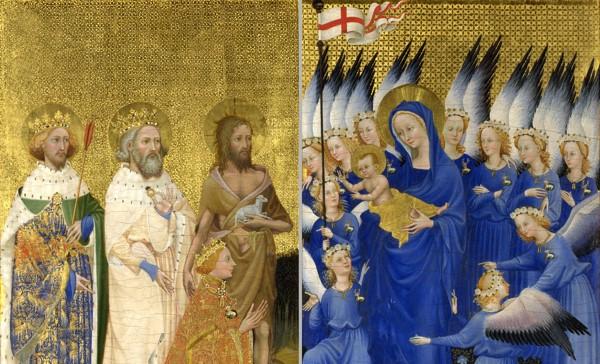The rededication of England as Mary’s Dowry on 29 March 2020 will happen in circumstances that could not have been envisaged when the act was first proposed some two and a half years ago – Before Corona. However, if it calls us to re-imagine and better understand gratitude and our desire for communion, particularly in light of a pandemic that is keeping us apart, then it can be an unexpected gift, writes Michael Kirwan SJ.
There is a lovely mistake on the Crux website concerning the rededication, on 29 March 2020, of England as the ‘Dowry of Mary’.[i] In what I presume is the curse of predictive spelling, the event is referred to as ‘reeducation’, which has a distinctly Maoist ring to it. More on that later ...
This devotional act is intended to help England face ‘contemporary personal and national challenges’. The rededication was first proposed by the Catholic Bishops’ Conference of England and Wales in November 2017; that is Before Corona (BC). Difficult as it is to believe, the very real need for national healing and reconciliation after Brexit has been totally overshadowed by a much more frightening and chaotic crisis. It is worth noting the action this week of the Irish Bishops, in consecrating Ireland to the Immaculate Heart of Mary ‘for protection from the coronavirus’. Both the consecration and the rededication are timed during the week of the Feast of the Annunciation (25 March).
The English ceremony (Welsh Catholics may be inclined to ask what this has to do with them?) reclaims this historical memory of England being offered to Mary as a thanksgiving gift. The meaning of ‘dowry’ is ambiguous; as well as its common meaning of a ‘bride price’, which a woman’s family paid to her husband at the time of the marriage, the ‘widow’s dowry’ referred to resources going the other way, i.e., the portion of a man’s property set aside and assigned to his wife if he died.
Most of us would have a question-mark about the suitability of this kind of imagery, and it is worth saying from the outset what the devotion of Mary’s dowry – Dos Mariae – is not about. Anthropologists of religion speak of the ancient practice of do ut des: ‘I give, in order to receive’. A believer makes an offering or sacrifice in order to win the favour of the gods; something is given (the sacrifice), so that something else is received (protection, blessing, etc.).
Another Latin phrase for this kind of transaction is quid pro quo. This makes religion into a glorified protection racket, and it is not what Christianity is about. We do not ‘buy’ our way into God’s favour. He already loves us and cares for us, he doesn’t need to be bribed. His gift to us of his Son is precisely that – a gift, not his side of a ‘bargain’ that requires payment from us.
So whatever Christianity is about, it is not about contractual arrangements like do ut des. We should not be misled, when we speak of dowries and the like, into thinking about contracts and financial deals.
Having made this clear, we can look at the history of the devotion and the title of Dos Mariae, which seems to be have been widespread by the middle of the fourteenth century, though Richard II is specifically invoked, since he implored the help of Our Lady in 1381 during the turbulence of the Peasants’ Revolt. Richard’s association with the cult is reinforced by the beautiful Wilton Diptych (1395), in which Richard and the Virgin and Child are closely associated with symbols of England. The rededication itself is centred on the national shrine of Our Lady in Walsingham, seeking to foster pilgrimages to this beautiful, special place. Here is an invitation to the nation to re-connect with its pre-Reformation past.
All very good, but worth noting, however, is the prominence of this devotion among exiled seminarians at the time of the Catholic Reformation, when England under Protestantism was felt to be in special need of Mary’s protection. And the shrine of Walsingham itself is witness to both the ancient Marian piety (from 1061), and the devastation of religious conflict in early modernity.
On the positive aspects of the rededication, I have no hesitation in deferring to a theological colleague, Sarah Boss, writing in the Catholic Herald of 19 March 2020.[ii] She sets out the centrality of Marian devotion for Christian, and not just Catholic, faith, listing a number of contemporary Protestant testimonies of Marian experiences. Jesus does not act as a ‘lone individual’. Devotion to Mary, and to the saints in general, attests to the sociality of human beings. ‘Without the saints, both living and departed, our Christian lives would be like the lives of friendless folk with no relatives’. In addition, neglect of Mary can lead to a forgetfulness of Jesus’s enfleshment in the Incarnation, in which Mary is both morally and physically involved.
With regard to England’s status, Boss says that ‘to be Our Lady’s Dowry is an enormous responsibility’, both for care of its natural beauty, and for compassion towards those afflicted in our towns and cities. This responsibility is a duty ‘to make our land truly Mariform’, that is, to make Christ’s presence in England (and in Britain) visible to all nations.
That theological affirmation chimes with what psychologists call the ‘return of the repressed’. This is the surprising re-emergence of a yearning for religious and spiritual meaning, even and especially in societies that claim to have left formal Christianity behind. From a playwright (Peter Shaffer): ‘Without worship we shrink; it’s as simple and as brutal as that’. From a philosopher (Paul Ricoeur): ‘Beyond the desert of criticism, we yearn to be called again’. The Catholic Germanist scholar Nicholas Boyle has audaciously argued that at the Reformation, ‘England’ shifted away from worshipping God to worshipping itself in the form of a strongly mythologised nation state. Sooner or later, surely, people will tire of this idolatry and re-discover, within themselves, as the poet Philip Larkin puts it, a ‘hunger to be more serious’.
And a desire – however much our culture may repress it – to engage once again in the simple ancient game of ‘give and receive’. But this does not mean a return to do ut des, the fearful bargaining with a deity who must be appeased or placated if humans are to flourish. What Christianity knows about is something different: the marvellous exchange of gifts, freely and joyfully offered and received. Recent theology has brought about a richer understanding of sacrifice and gift, of self-offering and self-gift; perhaps this has a place here.
It is easy to marshal the counter-arguments, which are not (all) to do with weary cynicism directed at traditional piety. What kind of presumption leads religious leaders to consecrate a secularised nation, so to speak, against its will? Do we really want to recover a devotion centred on the practice of ‘dowry-giving’, which in all its various meanings, is irredeemably patriarchal? Is our respect for Richard II’s devotion intact when we register that much of the ‘turbulence’ of his reign was self-inflicted (if this is a harsh judgment, blame William Shakespeare)? And if, as a result of Brexit, it is the whole nation in need of reconciliation, how far are we helped by a narrowly English devotion (one that – yet again! – brackets out the rest of Britain)?
These are sound objections, perhaps … and yet. We yearn, still.
I would urge us to go further, by making two fairly big points. The first concerns that amusing slip of the computer, which threw up the word ‘reeducation’ rather than ‘rededication’. Let’s leave aside the vision of hordes of illiterate Catholics, stubborn heretics and recalcitrant atheists being dragooned off to ‘re-education’ camps, where warped minds will be set straight. A kinder description of what is missing is ‘religious literacy’, a term that has become common in descriptions of the spiritual crisis of western societies. The inability of those societies to handle religious concepts, so as to acknowledge a legitimate hunger for the transcendent and accommodate it within the social, legal and political spheres, is a serious fault-line. Two intolerances – religious fundamentalism on the one hand, secularist exclusion of the sacred on the other – are each the sour fruit of religious illiteracy.
So, part of what this is about is education … or re-education … or the fostering of a genuine ‘religious literacy’. The ‘educational’ goal of the rededication is explicitly stated: to arrest a decline in understanding and appreciation of an ancient spiritual heritage, and recalling the present generation to that heritage.
But a genuine literacy is not just knowing the meaning of words and concepts, but also how these relate to one another, and how they are to be used. And much of the crisis of Catholic religious literacy is a lack not just of vocabulary, but of practical linguistic competence. An inadequate grasp of the big picture leaves Catholics often at a loss to explain how it all fits together. What are we supposed to do with Marian concepts, like ‘Immaculate Heart’, ‘Immaculate Conception’, ‘Virginal Conception’ – let alone Christological ones like ‘Incarnation’, or ‘consubstantial’?
‘England, Dowry of Mary’ may look more user-friendly because less abstract, but it still requires explanation, and it still needs to be fitted into the wider picture.
Let me start from a different place. The novelist Thomas Mann wrote a series of massive novels about the Joseph saga from the Book of Genesis. There is a recognition scene that is so beautiful that Mann openly admits that words nearly fail him. This is the banquet at which Benjamin almost recognises his disguised brother, Joseph, thought to be dead but alive after all. Instead of describing Benjamin’s emotions, however, Mann can only describe the expression on his face: ‘Just let someone try to describe what was happening now in Benjamin’s soul – in a soul which is on the point of believing!’
If Mann, who is not generally short of words (Joseph and his Brothers is 1,500 pages long), pauses reverently before the mystery of ‘a soul which is on the point of believing’, then so should we. It tells of encounters where words, however few, are charged with meaning: the words that pass between Joseph and his brothers, between the resurrected Jesus and those to whom he appears, and between Mary and Gabriel. It is why the Annunciation, the Feast of the Incarnation which we celebrate as I write these words, is the feast that gives the context and meaning for all Marian devotion, as Sarah Boss makes clear.
Why should this be? Because the momentous encounter of God and humanity, and the struggle of faith, fear and perplexity within Mary herself, testify to the mystery: ‘the state of a soul which is on the point of believing’. For all that the artist does not use words, his or her imagination is shaped by words that live, unlike the dully-repeated formulae of a narrow religious orthodoxy or a dogmatic secularism.
The second point is obvious. Sarah Boss’s commendation and appeal to make our country ‘truly Mariform’ was published a week ago – and yet it seems to have been written in a different epoch. Coronavirus has changed everything. The crisis that is causing the implosion of our world underlines every word of her commentary on the Incarnation, while presenting it in a stark, new context. When she writes that without the saints our Christian lives ‘would be like the lives of friendless folk with no relatives’, her words have a new chill for us, in our locked-down self-isolation. She urges Marian devotion as a reminder of Jesus’s enfleshment, therefore our common humanity. For the foreseeable future, however, the most vivid reminder of our interconnectedness and our desire for communion is a horrific, unexpected pestilence.
One can go a little further, and recognise here something of the scandal of the Incarnation. For all the politeness and courtesy with which Mary is approached by Gabriel, God seems to be ‘intruding’ on human territory. God transgresses the ‘social distance’ which, for the ancients, kept ‘the Holy’ and the human safely apart. But God’s transgression into our space, astonishingly, does not mean death, but a new proximity of shared life and love. The Incarnation, to repeat, is not do ut des: it is not an anxious bargain. Dos Mariae is the ‘gift of Mary’, who receives the gift, and gives herself in return. And here we see, depicted so many times by so many artists, ‘the state of a soul which is on the point of believing.’
When we ask about religious literacy, and where we find an adequate understanding and use of religious concepts and doctrines, we are drawn most easily to the artists and musicians, people who show us what the doctrines mean. If asked to explain the devotion of England as Dos Mariae, one cannot do much more than point to the bucolic serenity of the Walsingham statue of the Virgin and Child, or to the unspeakable majesty of the Wilton Diptych. Perhaps an indication of whether this will be a living devotion in the twenty-first century is whether an artist can ‘run with it’, as did the painter of the Diptych seven hundred years earlier.
Or to put this another way: is there a contemporary artist who can imagine England as Mary’s Dowry with the same audacity as John Collier has presented the Annunciation? While the poses of Mary and the Angel are conventional, Collier’s image of Mary certainly is not. She is in school uniform, reading a book; are the laces of her trainers untied?
The briefest of internet searches shows dozens of images of the Annunciation by contemporary artists. For these men and women, this tremulous, lucid encounter, in which everything is fresh and in the balance, is as inspirational as it was for their medieval and renaissance predecessors. Perhaps, we hope, some of them will re-imagine the Dos Mariae for us. Perhaps they will free its power to address the ‘contemporary personal and national challenges’, not just of the core faithful, but of those ‘on the brink of believing’. A country grown tired of the stale pronouncements – those of the believer as well as those of the despiser of belief – may be ready to respond better to a curious English tale about gratitude and gift, about the joy of dedication, and about the sheer relief of not having to worship ourselves the whole time.
Michael Kirwan is a British province Jesuit currently working in Ireland. He teaches and researches at the Loyola Institute, Trinity College, Dublin.
[i] https://cruxnow.com/church-in-uk-and-ireland/2020/02/catholic-church-prepares-to-rededicate-england-as-dowry-of-mary/
[ii] https://catholicherald.co.uk/we-have-a-duty-to-make-our-land-truly-mariform/






